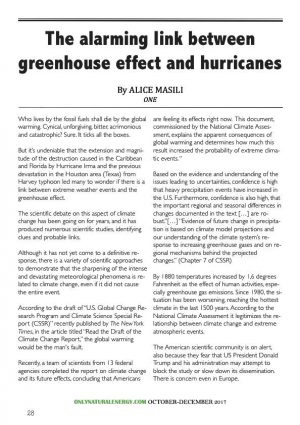 Who lives by the fossil fuels shall die by the global warming. Cynical, unforgiving, bitter, acrimonious and catastrophic? Sure. It ticks all the boxes.
Who lives by the fossil fuels shall die by the global warming. Cynical, unforgiving, bitter, acrimonious and catastrophic? Sure. It ticks all the boxes.
But it’s undeniable that the extension and magnitude of the destruction caused in the Caribbean and Florida by Hurricane Irma and the previous devastation in the Houston area (Texas) from Harvey typhoon led many to wonder if there is a link between extreme weather events and the greenhouse effect.
The scientific debate on this aspect of climate change has been going on for years, and it has produced numerous scientific studies, identifying clues and probable links.
Although it has not yet come to a definitive response, there is a variety of scientific approaches to demonstrate that the sharpening of the intense and devastating meteorological phenomena is related to climate change, even if it did not cause the entire event.
According to the draft of “U.S. Global Change Research Program and Climate Science Special Report (CSSR)” recently published by The New York Times, in the article titled “Read the Draft of the Climate Change Report,” the global warming would be the man’s fault.
Recently, a team of scientists from 13 federal agencies completed the report on climate change and its future effects, concluding that Americans are feeling its effects right now. This document, commissioned by the National Climate Assessment, explains the apparent consequences of global warming and determines how much this result increased the probability of extreme climatic events. “
Based on the evidence and understanding of the issues leading to uncertainties, confidence is high that heavy precipitation events have increased in the U.S. Furthermore, confidence is also high, that the important regional and seasonal differences in changes documented in the text […] are robust.”[…] “Evidence of future change in precipitation is based on climate model projections and our understanding of the climate system’s response to increasing greenhouse gases and on regional mechanisms behind the projected changes.” (Chapter 7 of CSSR)
By 1880 temperatures increased by 1,6 degrees Fahrenheit as the effect of human activities, especially greenhouse gas emissions. Since 1980, the situation has been worsening, reaching the hottest climate in the last 1500 years. According to the National Climate Assessment it legitimizes the relationship between climate change and extreme atmospheric events.
The American scientific community is on alert, also because they fear that US President Donald Trump and his administration may attempt to block the study or slow down its dissemination. There is concern even in Europe.
Following the massive heat wave that hit Europe in the summer of 2003, a team of British researchers started to use environmental data and model simulations to establish a statistical link between climate change and heat wave, giving life to the “science attributions”.
Researchers from the University of Melbourne, the Australian National University and the University of New South Wales of Sydney also argue that the abnormally high temperature recorded in Australia in 2013 are relatively substantial evidence of human contributions.
According to their report, published in the Bulletin of the American Meteorological Society, meteorological phenomena such as heat waves, followed by droughts and floods, are more comfortable to attribute to climate change, but the science does not assign a single cause to the magnitude and severity of storms. The National Oceanic and Atmospheric Administration (NOAA), in particular, the division of Geophysical Fluid Dynamics Laboratory (GFDL), which contribute to the CSSR, has recently updated one of the most complete and articulated reviews of studies published so far on hurricane relationship and global warming. By developing more and more accurate statistical prediction models, researchers are increasingly confident to prove that storm intensity, droughts, and heatwaves occur more frequently because of man.
Research suggests that human activity has probably led to changes, but we are still unable to detect them because of their scale and our technical
limits in analyzing.
It is proven that rising sea levels, due to global warming, brings more likely flood in coastal areas to hurricane routes, and there is a relationship between increasing temperatures and storm intensity formed in the Gulf of Mexico. Based on the data collected over the years, researchers also agree that anthropogenic warming will lead to tropical cyclones (hurricanes, typhoons, tropical storms) at an average of 2 to 11 percent depending on prediction models. Assuming that the size of storms does not diminish – there are no suggestions – the destructive potential will be even more powerful.
The High-Resolution Atmospheric Model (HiRAM C180; 50-km grid) used to simulate the genesis of tropical cyclones can reproduce the inter-annual variability of tropical cyclone occurrence quite realistically, especially in the Atlantic basin.
The studies cited by the GFDL also assert that the most intense storms are getting stronger in recent years. Tropical cyclones with the strongest winds ever recorded have occurred in the last two years, confirming the models’ trend. Also, stronger winds increase the risk of damages to buildings and trees, leading to the production of more debris that can hinder water outflows and make coastal areas even more dangerous during storms.
To highlight this connection, Carbon Brief (read the article “Mapped: How climate change affects extreme weather around the world”) mapped all the extreme weather events subjected to relevant studies with the aim of tracking in real time the evolution of the attribution of these climatic phenomena.
An average of ten meteorological disasters has been estimated, each one costing more than a billion dollars between 2012 and 2016. Despite numerous parameters are the concause (population density, building installations in coastal areas, etc.), the impact of heating can no longer be denied.
Alice Masili


